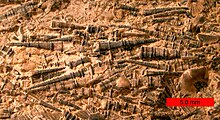Tentaculita
Appearance
| Tentaculita Temporal range: Early Ordovician to Middle Jurassic (Vinn 2010)
| |
|---|---|

| |
| Tentaculitids from the Devonian of Maryland. | |
| Scientific classification | |
| Domain: | Eukaryota |
| Kingdom: | Animalia |
| Superphylum: | Lophotrochozoa (?) |
| Class: | †Tentaculita Boucek, 1964 |
| Taxa of uncertain placement | |
| |
Tentaculita is an extinct class of uncertain placement ranging from the Early Ordovician to the Middle Jurassic. They were suspension feeders with a near worldwide distribution. For a more thorough discussion, see Tentaculites.
The presence of perforate septa and "septal necks" has been used to argue for a cephalopod affinity, whereas the shell microstructure, notably the presence of punctae, points to a brachiopod relationship.[1]
Subdivisions
- Subclasses
- Orders
- Genera
References
- ^ Weedon, Michael J. (1990). "Shell structure and affinity of vermiform 'gastropods'". Lethaia. 23 (3): 297–309. doi:10.1111/j.1502-3931.1990.tb01455.x.
- Farsan, N. M. (1994). Tentaculiten: Ontogenese, Systematik, Phylogenese, Biostratonomie und Morphologie. Abhandlungen der Senckenbergischen Naturforschenden Gesellschaft 547: 1-128.
- Vinn, O. (2010). "Adaptive strategies in the evolution of encrusting tentaculitoid tubeworms". Palaeogeography, Palaeoclimatology, Palaeoecology. 292 (1–2): 211–221. doi:10.1016/j.palaeo.2010.03.046. Retrieved 2014-01-11.
- Vinn, O.; Zatoń, M. (2012). "Phenetic phylogenetics of tentaculitoids — extinct problematic calcareous tube-forming organisms". GFF. 134: 145–156. doi:10.1080/11035897.2012.669788. Retrieved 2014-06-11.
